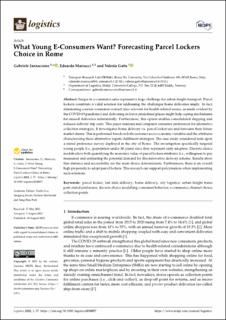| dc.description.abstract | Surges in e-commerce sales represent a huge challenge for urban freight transport. Parcel lockers constitute a valid solution for addressing the challenges home deliveries imply. In fact, eliminating courier–consumer contact (also relevant for health-related issues, as made evident by the COVID-19 pandemic) and delivering in fewer predefined places might help coping mechanisms for missed deliveries substantially. Furthermore, this option enables consolidated shipping and reduced delivery trip costs. This paper analyses and compares consumer preferences for alternative collection strategies. It investigates home delivery vs. parcel locker use and forecasts their future market shares. This is performed based on both customer socio-economic variables and the attributes characterising these alternative logistic fulfilment strategies. The case study considered tests upon a stated preference survey deployed in the city of Rome. The investigation specifically targeted young people (i.e., population under 30 years) since they represent early adopters. Discrete choice models allow both quantifying the monetary value of parcel lockers attributes (i.e., willingness to pay measures) and estimating the potential demand for this innovative delivery scheme. Results show that distance and accessibility are the main choice determinants. Furthermore, there is an overall high propensity to adopt parcel lockers. This research can support policymakers when implementing such solutions. View Full-Text Keywords: parcel locker, last mile delivery, home delivery, city logistics, urban freight transport, stated preference, discrete choice modelling; consumer behavior, e-commerce, channel choice, collection points | en_US |

